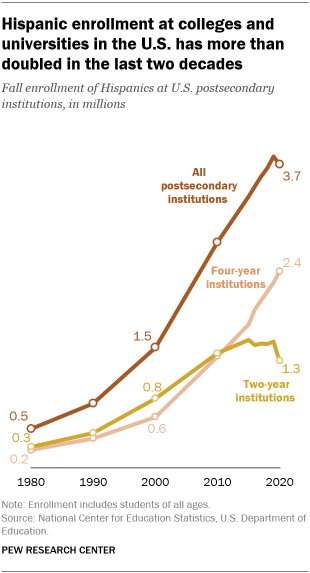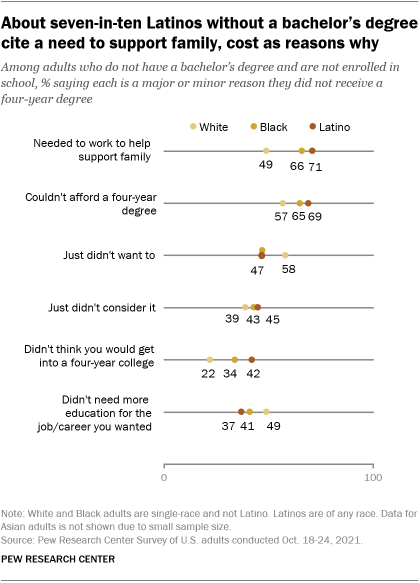
By Lauren Mora
Hispanic enrollment at postsecondary institutions in the United States has seen an exponential increase over the last few decades, rising from 1.5 million in 2000 to a new high of 3.8 million in 2019 – partly reflecting the group’s rapid growth as a share of the overall U.S. population.

However, the COVID-19 pandemic brought a decline in postsecondary enrollment among Hispanics and most other racial and ethnic groups. In fall 2020, there were 640,000 fewer students – including nearly 100,000 fewer Hispanics – enrolled at U.S. colleges and universities than in the previous year, according to the National Center for Education Statistics (NCES).
The decline for Hispanics, and other racial and ethnic groups, in 2020 was driven by a drop in enrollment at two-year institutions. Hispanic enrollment at two-year colleges declined by about 230,000, or 15%, from 2019 to 2020. It appears that this trend continued into fall 2021, as there was a decline in the number of higher education institutions where Hispanics make up at least 25% of students – known as Hispanic-Serving Institutions – from 569 in fall 2020 to 559 in fall 2021. (NCES has not yet released postsecondary enrollment data for fall 2021.)
Hispanic enrollment at four-year institutions, by contrast, continued to rise even during the first year of the pandemic, increasing by about 140,000 students, or 6%, from 2019 to 2020. Hispanic enrollment at such institutions has increased every year for decades. Between 2000 and 2020, the number of Latinos enrolled at four-year institutions jumped from 620,000 to 2.4 million, a 287% increase. By comparison, overall student enrollment at four-year institutions in the U.S. grew by 50% during this time.
How we did this

Latinos make up a growing share of all students enrolled at postsecondary institutions. In 1980, there were about 470,000 Latinos enrolled at degree-granting postsecondary institutions, accounting for 4% of all students. By 2000, Latino enrollment had increased to 1.5 million, or 10% of all students. And by 2020, 3.7 million Latinos were enrolled, accounting for a fifth of all postsecondary students.
Asian enrollment at postsecondary institutions has also grown sharply in recent decades, though not as quickly as Hispanic enrollment. The Asian share of postsecondary students nearly quadrupled from 2% in 1980 to 8% in 2020. The share of postsecondary students who are Black increased far more slowly, from 9% in 1980 to 13% in 2020, while White students saw a considerable decrease in their share of enrollment, from 84% to 54%.

Despite growing enrollment, relatively small shares of young Hispanics are enrolled in college or have obtained a bachelor’s degree. In 2021, about three-in-ten Latinos ages 18 to 24 (32%) were enrolled at least part time in college, a similar share to Black Americans (33%) and a lower share than among White (37%) and Asian (58%) adults of the same age, according to a Pew Research Center analysis of Current Population Survey data. Among Latinos, some 35% of young women 18 to 24 were enrolled at least part time in college in 2021, compared with 28% of men of the same age group.
In 2021, about a quarter of Latinos ages 25 to 29 (23%) had earned a bachelor’s degree, up from 14% in 2010. A similar share of Black Americans in this age group (26%) had obtained a bachelor’s degree, while 45% of White Americans and 72% of Asian Americans ages 25 to 29 had done so. Hispanic women ages 25 to 29 were more likely than Hispanic men in the same age range to have a college degree (27% vs. 20%) – a pattern also seen among other racial and ethnic groups.
Overall, a 62% majority of U.S. adults ages 25 and older do not have a bachelor’s degree, including about eight-in-ten Hispanics (79%).
Financial constraints a major reason why Hispanics do not finish a four-year degree
Financial considerations are a key reason why Americans overall do not complete a four-year degree, and this is particularly true for Hispanics, according to an October 2021 Pew Research Center survey.

Among Latinos who do not have a bachelor’s degree and are not enrolled in school, about seven-in-ten Latinos (71%) say a major or minor reason why is that they need to work to help support family, while 69% say they couldn’t afford a four-year degree.
Affordability restrictions may include the overall cost of college, lack of reliable transportation or a desire to not take on debt. Hispanics are more likely than other students to avoid taking on debt and more likely to report difficulties paying back student loans.
Personal factors also play a role in college completion. Close to half of Hispanics who have not obtained a four-year degree (47%) say they just did not want to pursue one. There is a notable difference by gender, with 54% of Hispanic men and 40% of Hispanic women citing this as a reason for not finishing college.
Other factors play a role, too. Among Latinos without a bachelor’s degree, about four-in-ten (42%) say they did not think they would get into a four-year college – a significantly higher share than among White Americans (22%). In addition, 37% of Latinos without a bachelor’s degree say they did not think they needed a four-year degree for the job or career they wanted. This is similar to the share of Black Americans who say the same, (41%) but lower than the share of White Americans (49%).



Be the first to comment